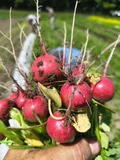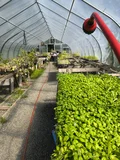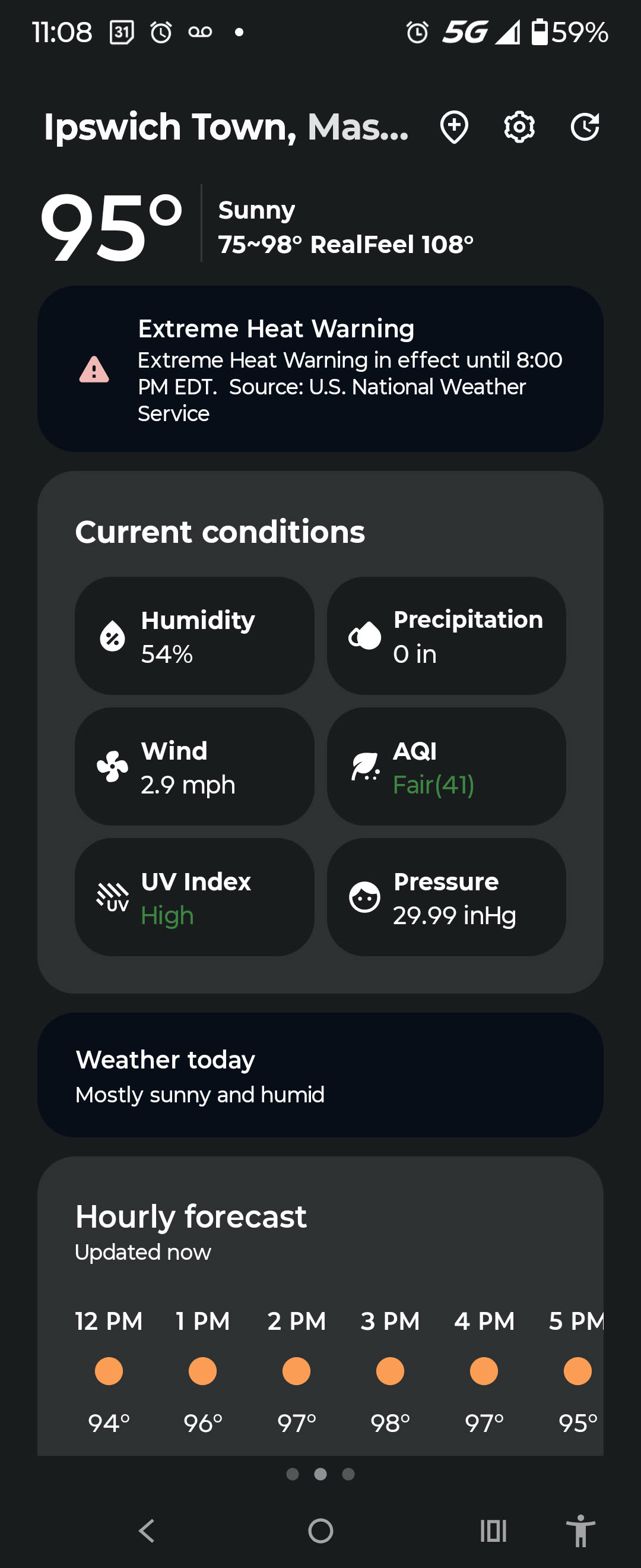TL;DR
Despite the heat wave, there’s always work to do on the farm. In small batches and with plenty of water, seven of us got done what needed to get done.
Hottest Day on Record
From 85 degrees at 8am to 105 degrees by 1pm, today was one of the hottest days on record for coastal (and all of Massachusetts). Still there is work to do and a way to do it: small spikes and batches, cool-down breaks and plenty of water. Prioritization over what MUST be done vs. all the things that should be done on a day like today is so necessary.
For instance, watering the plants which don’t have deeply established root systems like the kale and chard already do, such as lettuces, radishes and baby carrots is really important. If their roots only go down into the soil two or three inches, and the top soil is dry to that depth, the plants will simply not survive for long in the extreme heat. Whole crops will be lost simply due to heat stress and lack of water.
All that time preparing beds, seeding or transplanting, weeding, waiting for them to grow…only to be done in by two or three hot days and no irrigation…would be irresponsible.
Watering the Greenhouse and Moving Irrigation
Today we watered the greenhouse for an hour three times because it was so hot that each time we checked the trays, they were dried out. The last one I did was at 4:30pm so I’m interested tomorrow morning to see how dry the overnight heat got them again.
We also moved the tripod sprinkler from the tomatoes and carrots mid-field to the high field where the radishes, lettuces, onions, and cabbages are. Mostly this took about 30mins to disconnect and drain the tubing, then moving it and reconnecting it in the new location.
Why move things at all? Because that amount of durable 2-inch tubing not to mention the tripods and sprinklers would cost a lot of money and they’re only needed in certain places at certain times (like this heat wave) per season. Yes, moving it around takes time which is opportunity cost over another activity, and muscle effort. But at this point, it’s the responsible balance between money and time spend here.
While We Worked Hard, They Worked Harder
The farm team of seven today worked very hard and sweat a lot. Meanwhile because of the ideal conditions for haying, the groundskeepers crew of four made dozens of bails of hay from the grasses terminated over the past few days and left to dry until now. They should win awards for this, like every year seemingly on the hottest day of the season, since you don’t want to bail wet or still-green grass as it will be prone to rot if you do.
Moving from Deepseek to Better Reasoning and Process
The past few weeks of using the Deepseek-R1:8b model have been…not worth it. I thought there would be performance and speed gains, but there were not (granted, I’m running inference on CPU, not GPUs). I thought the reasoning loops would produce better summaries in terms of content and theme extraction as well as completeness, but they did not. I though it would produce fewer hallucinations, but it actually came with more. It often chooses to switch to outputting Chinese (makes sense from its from research origins and training content), even though I only input English as well as explicitly prompt it to output that.
As mentioned in previous posts, my other side-work around multi-participant transcription and diarization taught me that balancing process with the right tech for the use case is really important with these LLM/AI infused workflows. So this weekend, I plan to try a few incremental (and hopefully positive) changes:
- Try the existing langchain process with a different ‘reasoning’ model
- Adjust the process to be more like my new transcription processing work
- Try different parts of the new process with different models (reasoning vs. non-reasoning)
For today, the first version of the auto-generated summaries was an absolute mess, the worst it’s been since this weekend’s server reboot forcing a new version of the model (Deekseek-R1-0528). Despite their claims of improved performance and fewer hallucinations, I’ve seen the opposite. Maybe it’s just mad that it has to work on my CPU-based cluster instead of it’s cushy GPU upbringing.
Either way, I went back and crossed out the hallucinations in yesterday’s Deepseek-generated summary to be very clear about how this farm does NOT use herbicides or pesticides, and in the future I may include a part in prompts to ensure that it has the context that we use organic practices.
AI-Generated Summary from Field Notes
UPDATE: For the first time in 3 months, I had to hold off publishing within 24hrs because I switched my attention to diagnosing and fixing what was going wrong with the newest Deepseek update. At a later time, I’ll publish the artifacts, bizarre behaviors, and contributing factors analysis, but for now I moved to a different reasoning model and many of the LLM hallucinations went away.
Using: qwen3:4b
Final Consolidated Summary
Main Themes
- Extreme Heat Impact: Prolonged high temperatures (e.g., 100°F) strain crops, workers, and irrigation systems, necessitating adaptive farming practices.
- Organic Farming: Reliance on natural methods like mulching, manual weeding, and manual irrigation, avoiding synthetic chemicals.
- Crop Management: Harvesting, weeding, and irrigation for stress-prone crops (e.g., chard, radishes, greenhouse plants).
- Hay Production: Critical for soil moisture retention, managed under dry conditions by the groundskeeping crew.
- Watering Challenges: Frequent irrigation required for greenhouse and stressed crops, with a focus on preventing plant stress.
Activities Performed by the Intern
- Harvested chard, radishes, and salad turnips.
- Weeded leeks and reorganized irrigation lines.
- Moved refrigerators to optimize barn cooling.
- Watered greenhouse three times daily due to extreme dryness.
- Washed eggs and observed hay-making processes.
- Assisted in pop-up market prep in Essex.
New Things Not Yet Encountered
- Greenhouse Watering Frequency: Watering the greenhouse three times daily, a new experience.
- Hay-Making Process: Observing the groundskeeping crew’s efforts under heat.
- Irrigation Line Reorganization: Adjusting systems to meet crop needs.
- Heat-Induced Crop Stress: Noticing plant stress from prolonged dryness and high temperatures.
Questions and Future Research
- How to mitigate heat stress on crops (e.g., shade structures, watering timing).
- Does mulching with salt marsh hay improve soil moisture retention?
- Will upcoming rain affect the current hay crop, and how to manage it?
- What is the optimal greenhouse watering frequency in extreme conditions?
- How to ensure worker safety and productivity during heatwaves.
Suggested Actions
- Adjust irrigation schedules based on heat and plant stress.
- Monitor greenhouse watering to prevent yield loss.
- Plan for rain impact on hay and crops (e.g., harvesting timing).
- Install shade structures to protect crops during heatwaves.
- Implement hydration breaks and cooling measures for workers.
- Track mulching benefits (soil moisture, crop health) to assess long-term impacts.
Part 1
Main Themes:
- Extreme Weather Conditions: The record-breaking heat on June 24th on the North Shore of Massachusetts.
- Environmental Impact: The potential effects of extreme weather on the farm’s operations, crops, and livestock.
Activities Performed by the Intern:
- Observation of Weather: Noted the record-breaking heat as the first entry in the field notes.
- Documentation: Recorded the date, weather condition, and its significance (hottest on record).
New Things Not Yet Encountered:
- Record Heat: The intern may have encountered this extreme weather for the first time, which is unusual for the region.
- Impact on Farm Operations: The intern may not have previously experienced such a severe heat event, prompting a need to assess its effects.
Questions and Future Research Areas:
- How does prolonged extreme heat affect crop yields and growth patterns?
- What measures can be taken to mitigate heat stress in livestock?
- How will the farm’s irrigation and watering schedules need to be adjusted for extreme heat?
- What long-term implications does this heat event have for the region’s climate and agricultural practices?
Suggested Actions:
- Monitor Crops: Check for signs of heat stress (e.g., wilting, reduced growth) in crops.
- Adjust Irrigation: Implement more frequent or higher-volume watering to counteract evaporation.
- Livestock Care: Ensure shaded areas, cooling systems, and increased feed availability for animals.
- Record Weather Trends: Track future weather patterns to prepare for potential heat events.
- Farm Planning: Develop contingency plans for extreme weather, such as emergency cooling systems or crop rotation adjustments.
Part 2
Main Themes
- Extreme Heat Impact: The farm faces intense heat (100°F) affecting both crop health and worker efficiency.
- Organic Farming Practices: No synthetic pesticides/herbicides; reliance on natural methods like mulching and irrigation.
- Crop Management: Harvesting, weeding, irrigation, and greenhouse care for stress-prone plants.
- Hay Production: Groundskeeping crew manages hay-making despite heat, emphasizing dry conditions.
- Watering Challenges: Frequent irrigation needed for greenhouse and stressed crops, with a focus on preventing plant stress.
Activities Performed by the Intern
- Harvesting: Collected chard, radishes, and salad turnips.
- Weeding: Tended to leeks in the garden.
- Refrigerator Management: Moved refrigerators to optimize barn cooling.
- Irrigation Adjustments: Reorganized irrigation lines and adjusted watering schedules.
- Greenhouse Care: Watered the greenhouse three times daily due to extreme dryness.
- Egg Processing: Washed eggs, a routine task regardless of season.
- Hay Monitoring: Observed the hay-making process, noting its importance in dry conditions.
- Market Prep: Assisted in preparing the pop-up market in Essex.
New Things Not Yet Encountered
- Greenhouse Watering Frequency: Watering the greenhouse three times in a day, a new experience.
- Hay-Making Process: Observing the groundskeeping crew’s hay-making efforts under heat.
- Irrigation Line Reorganization: Adjusting irrigation systems to meet crop needs.
- Heat-Induced Crop Stress: Noticing plant stress from prolonged dryness and high temperatures.
Questions and Future Research
- Heat Resilience: How to mitigate heat stress on crops (e.g., shade structures, timing of watering).
- Mulching Effectiveness: Can mulching with salt marsh hay improve soil moisture retention?
- Rain Impact on Hay: Will the upcoming rain affect the current hay crop, and how to manage it?
- Greenhouse Watering Strategy: Optimal frequency and timing for greenhouse watering in extreme conditions.
- Worker Hydration Protocols: How to ensure worker safety and productivity during heatwaves.
Suggested Actions
- Adjust Irrigation Schedules: Increase frequency or adjust timing based on heat and plant stress.
- Monitor Greenhouse Watering: Ensure plants receive adequate water to prevent yield loss.
- Plan for Rain: Develop strategies to manage potential rain impact on hay and crops.
- Improve Shade Structures: Consider adding shade to protect crops during heatwaves.
- Hydration Management: Implement hydration breaks and cooling measures for workers.
- Document Mulching Benefits: Track soil moisture and crop health post-mulching to assess long-term benefits.
[end of post]
Enjoy Reading This Article?
Here are some more articles you might like to read next:







